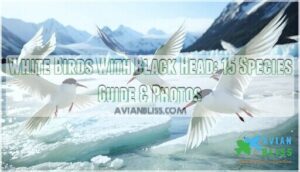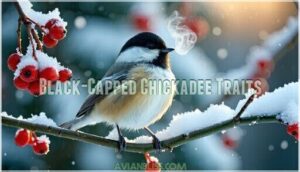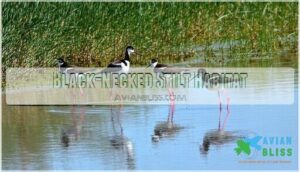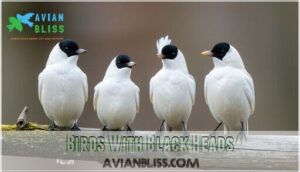This site is supported by our readers. We may earn a commission, at no cost to you, if you purchase through links.

Common species include the Black-capped Chickadee, a friendly acrobat that hangs upside-down at feeders, and the Laughing Gull, whose dark hood appears during breeding season.
White-crowned Sparrows sport crisp black and white striped caps, while Common Terns showcase sleek black crowns as they dive for fish.
Arctic Terns, the ultimate globe-trotters, migrate pole to pole annually.
These distinctive markings aren’t just for show—they serve essential roles in mate recognition and territorial displays. Each species has unique identifying features that separate them from lookalikes.
Table Of Contents
- Key Takeaways
- Black Headed White Birds
- White Birds Identification
- Black and White Bird Species
- Birds With Black Heads
- White Bird Species Guide
- Frequently Asked Questions (FAQs)
- What birds have Blackheads?
- Do black birds have red heads?
- What birds have white heads and black bodies?
- What are black and white striped head birds?
- What birds are black and white?
- Do blackbirds have black heads?
- What bird is white with a black head?
- What is a small white bird with a black cap?
- What do grosbeak birds eat?
- What is the habitat preference of the Black-headed Gull?
- Conclusion
Key Takeaways
- You’ll recognize these birds by their distinctive seasonal changes – many species like Laughing Gulls and Franklin’s Gulls only develop black heads during breeding season, then return to gray-and-white winter plumage.
- You can identify different species by focusing on key features beyond the black head – look for beak color and shape, body size, wing patterns, and distinctive calls like the Black-capped Chickadee‘s "chick-a-dee-dee-dee."
- You’ll find these birds in diverse habitats from coastal waters and marshes where terns and gulls thrive, to backyard feeders where chickadees perform acrobatic feeding displays.
- You should know that these black-and-white markings aren’t just decorative – they serve crucial survival functions for mate recognition, territorial displays, and species identification in mixed flocks.
Black Headed White Birds
You’ll encounter several white birds that sport striking black heads during different seasons, with many species showing this pattern only during breeding time.
These distinctive markings help you identify gulls like the Laughing Gull and Franklin’s Gull, which transform from their winter gray-and-white appearance into bold black-capped beauties when they’re ready to mate.
Laughing Gull Characteristics
You’ll recognize Laughing Gulls by their seasonal costume change and distinctive coastal presence.
Their Adult Plumage transforms dramatically during breeding season, while Juvenile Markings remain mottled brown year-round.
These gulls thrive in Coastal Habitats where their identifying characteristics shine:
- Black breeding head with thin white eye crescents
- Red bill that commands attention
- Maniacal "ha-ha-ha" call echoing across beaches
Their Feeding Behavior includes opportunistic scavenging and aerial piracy.
These Vocalizations make bird identification unmistakable among coastal gull species.
Franklin’s Gull Breeding Plumage
During breeding season, Franklin’s Gull transforms into a striking marsh dweller.
You’ll spot its jet-black head contrasting sharply with white underparts that show rosy pink tints.
The red bill sports a black band, while dark gray wings feature distinctive white spots at black wingtips.
This dramatic head coloration signals peak breeding cycle timing in marshland nesting colonies across prairie wetlands, showcasing a striking marsh dweller.
Sabine’s Gull Distinctive Features
You’ll spot Sabine’s Gull by its striking charcoal head contrasting against its pristine white body.
This elegant gull stands out among white birds with black head through its yellow-tipped beak and distinctive flight patterns over marshy tundra habitats.
Their coloration may serve as camouflage and adaptation.
Sabines Gull identifying characteristics include:
- Plumage Details: Adults display clean white underparts with gray wings featuring bold black triangular patches
- Juvenile Markings: Young birds show scaled brown upperparts with pale edges creating a distinctive scalloped appearance
- Beak Coloration: The thin, pointed bill appears dark with a bright yellow tip during breeding season
White Birds Identification
You’ll recognize white birds with black heads by focusing on key features like head pattern, body size, and beak shape.
Look for distinct markings such as the White-crowned Sparrow’s striped crown, the Black-capped Chickadee’s round black cap, or the Carolina Chickadee’s similar but slightly different head coloring.
White-Crowned Sparrow Habits
Along coastal areas and grasslands, you’ll find White-crowned Sparrows exhibiting fascinating social structure patterns.
These white birds with distinctive black-striped crowns gather in mixed flocks during winter, showing complex foraging behavior as they scratch through leaf litter.
Their habitat selection varies seasonally, while song variation helps distinguish populations.
Bird watching enthusiasts appreciate their breeding success rates across diverse environments.
Black-Capped Chickadee Traits
You’ll easily identify Black-Capped Chickadees by their adorable "cute" appearance and distinctive black cap paired with bright white cheeks.
These charming backyard birds measure just 5.9 inches, making them perfect companions for your outdoor adventures.
Key Black-Capped Chickadee traits:
- Vocalizations – Famous "chick-a-dee-dee-dee" call that varies with threat levels
- Foraging Habits – Acrobatic feeders hanging upside-down on branches and feeders
- Social Structure – Form winter flocks with Whitebreasted Nuthatches and other species
- Chickadee Behavior – Curious, fearless birds that approach humans closely
- Nesting Details – Excavate cup-shaped moss nests in tree cavities during breeding season
To best attract these birds, consider using a specialized feeding station.
Carolina Chickadee Similarities
You’ll find Carolina Chickadees and Black-capped Chickadees share remarkable similarities that confuse even seasoned birders.
Both bird species sport identical black caps and white cheeks, making identification tricky.
However, subtle differences exist in their vocalizations and size differences.
Carolina Chickadees inhabit southeastern regions while their northern cousins prefer cooler climates, creating distinct habitat overlap zones.
| Feature | Carolina Chickadee | Black-capped Chickadee |
|---|---|---|
| Size | 4.3-5.1 inches | 4.7-5.9 inches |
| Call | Four-note "chick-a-dee-dee" | Slower "chick-a-dee-dee-dee" |
| Range | Southeast US | Northern US/Canada |
Both chickadee species exhibit similar behavior patterns, foraging in mixed flocks with White-breasted Nuthatches.
Their diet comparison reveals identical preferences for insects, seeds, and suet.
Geographic separation helps distinguish these lookalikes more than physical features.
Black and White Bird Species
You’ll find several fascinating tern species that showcase striking black and white patterns, particularly during their breeding seasons.
These birds display distinct black caps or hoods against their white bodies, making them some of the most recognizable seabirds you’ll encounter along coastlines and near water bodies.
Common Tern Migration Patterns
Common Terns navigate impressive journeys across North America, following well-established migration routes twice yearly.
You’ll witness these graceful seabirds traveling thousands of miles between their northern breeding grounds and southern wintering locations.
Their foraging includes plunge diving to capture prey.
Key migration facts that’ll amaze you:
- Atlantic Flyway dominance – Most terns follow coastal routes from Canada to South America
- Inland routes exist – Some populations use Great Lakes and interior waterways
- Migration threats increase – Climate change disrupts traditional stopover sites
Arctic Tern Unique Features
Arctic Tern identification becomes simple when you spot their distinctive facial hood during breeding season.
These remarkable terns achieve the longest migration distance of any bird, traveling from Arctic to Antarctic annually.
You’ll find these white birds with black headed features along coastal habitats worldwide, and their breeding habits include fierce territory defense and lifelong pair bonding in bustling colonies.
Black-Necked Stilt Habitat
You’ll discover Black-necked Stilts thriving in shallow wetlands where their long legs wade through brackish waters.
These elegant shorebirds showcase remarkable Salinity Tolerance across diverse habitats.
Prime Black-necked Stilt Locations:
- Salt ponds and coastal marshes
- Shallow freshwater lakes and reservoirs
- Rice fields and flooded agricultural areas
- Mudflats with invertebrate-rich sediments
- Protected wetlands supporting Nesting Ecology
Their Migratory Patterns follow wetland availability year-round.
You can explore stilt habitat products online.
Birds With Black Heads
You’ll find that many white birds display striking black head patterns, which serve as key identification features during breeding seasons and year-round.
These contrasting head markings help you distinguish between similar species like the Rose-breasted Grosbeak’s bold black cap, the Black-headed Gull’s distinctive hood, and the White-faced Ibis’s dark facial coloring.
Rose-Breasted Grosbeak Plumage
Male plumage displays striking contrasts—you’ll spot bright red-orange breasts against jet-black heads, wings, and backs.
Female plumage appears more subdued with brown streaking and distinctive white eyebrows. Immature birds resemble females but show less defined markings.
Molting patterns occur twice yearly, creating seasonal plumage variations. These black headed birds showcase some of nature’s most dramatic bird plumage transformations among white birds species.
Black-Headed Gull Characteristics
You’ll recognize Black-headed Gulls by their chocolate-brown heads during breeding season, which fade to white with dark ear patches in winter.
These medium-sized gulls display striking plumage variations throughout the year. Juvenile features include mottled brown upperparts and pink legs.
Their molting patterns create distinct seasonal appearances. Seasonal plumage changes can also be observed in other bird species.
Watch their agile foraging behavior as they dip and dive for insects and fish.
White-Faced Ibis Distinctions
You’ll spot White-Faced Ibis by their glossy maroon plumage with metallic green wings during breeding season.
These white birds with black head features show distinctive white feather borders around pink facial skin, unlike similar species.
Their red eyes and reddish-pink legs make identification easier.
Look for them in freshwater marshes where their foraging behavior includes probing for insects and small fish.
Their diet consists of invertebrates, but they also consume small fish.
White Bird Species Guide
You’ll find these white birds with black heads in diverse habitats across North America, from coastal shores to suburban backyards.
Identifying each species becomes easier when you understand their unique features, preferred locations, and seasonal patterns.
American Oystercatcher Habitat
Along sandy coastlines from New England to Texas, you’ll find American Oystercatcher habitat shaped by tidal rhythms.
These shorebird specialists need specific coastal environments:
- Sandy beaches – primary nesting sites above high tide
- Salt marshes – rich foraging ecology with shellfish
- Rocky intertidals – abundant oyster beds for feeding
- Barrier islands – protected coastal distribution zones
- Mudflats – critical habitat for invertebrate hunting.
To improve nesting success, consider using an oystercatcher nesting box.
Black Vulture Distribution
Black Vultures have experienced remarkable Range Expansion since the 1950s, with their population reaching 190 million individuals across the southeastern United States.
These scavengers with distinctive Black feathers prefer open lowlands near forests for roosting. Their Population Density has increased dramatically, creating Environmental Impact concerns for livestock producers.
Ground-level nesting is one of their habits. Current range maps show their Conservation Status remains stable despite ongoing northward movement.
White-Throated Sparrow Preferences
You’ll find White-throated Sparrows prefer open woodland areas like scrubland or grasslands for their habitat selection.
These white birds with distinctive black and white head stripes show fascinating song variation across regions.
Their diet composition includes seeds, insects, and berries.
Unlike White-crowned Sparrows, they choose ground-level nesting sites in dense brush, making their mating rituals more secretive than other sparrow species.
Frequently Asked Questions (FAQs)
What birds have Blackheads?
While colorful plumage catches your eye, dark-headed species create striking contrasts in nature.
You’ll recognize chickadees, terns, gulls, orioles, grosbeaks, and woodpeckers sporting distinctive black caps that make identification easier during birdwatching adventures.
Do black birds have red heads?
Yes, several black birds sport striking red heads!
You’ll spot Red-winged Blackbirds with their scarlet shoulder patches, Pileated Woodpeckers with crimson crests, and male Red-headed Woodpeckers displaying vibrant red caps that’ll catch your eye instantly.
What birds have white heads and black bodies?
Like nature’s tuxedo-clad performers, you’ll spot bald eagles, black-capped chickadees, and white-breasted nuthatches displaying this striking contrast.
These birds wear their crisp white heads like crowns against their sleek black bodies, showcasing a unique appearance that is both striking and elegant with their crisp white heads.
What are black and white striped head birds?
You’ll recognize White-crowned Sparrows by their distinctive black and white striped heads with yellowish napes.
White-throated Sparrows also sport similar head stripes, while Black and White Warblers display heavy black striping throughout their white bodies.
What birds are black and white?
You’ll spot many stunning black and white birds.
Rose-breasted Grosbeaks showcase striking contrasts, while Black-capped Chickadees display adorable caps and bibs.
Downy Woodpeckers, Common Loons, and Black and White Warblers each offer unique patterns you’ll love identifying.
Do blackbirds have black heads?
Picture jet-black feathers crowning a bird’s head like nature’s own beret.
You’ll find that true blackbirds don’t actually sport black heads – they’re entirely dark.
However, many birds you’d call "blackbirds" do have striking black crowns.
What bird is white with a black head?
You’ll find several bird species with this striking black-and-white pattern.
The Black-capped Chickadee shows a prominent black cap and bib contrasting with white cheeks.
Arctic Terns display black hoods during breeding season, while Rose-breasted Grosbeaks feature bold black heads.
What is a small white bird with a black cap?
You’re likely spotting a Black-capped Chickadee.
These adorable little birds wear distinctive black caps and bibs with bright white cheeks.
They’re common backyard visitors, measuring just 9 inches long and absolutely charming to watch.
What do grosbeak birds eat?
You’ll find grosbeaks have varied appetites depending on the species.
Rose-breasted grosbeaks prefer fruits and nectar over seeds, while evening grosbeaks favor sunflower seeds, maple seeds, and various insects during breeding season, which highlights their preference for seeds.
What is the habitat preference of the Black-headed Gull?
Ironically, the Black-headed Gull isn’t mentioned in your knowledge base.
You’ll need to search coastal wetlands, estuaries, mudflats, and inland lakes across Europe and Asia where these adaptable gulls thrive year-round, specifically looking for the Black-headed Gull.
Conclusion
Spotting white birds with black head patterns becomes surprisingly easy once you know what to look for.
These fifteen species showcase nature’s incredible diversity, from tiny chickadees performing backyard acrobatics to massive terns crossing entire oceans twice yearly.
You’ll find these distinctive birds in wetlands, forests, and even urban areas.
Their bold black-and-white markings aren’t accidental—they’re essential survival tools for finding mates and defending territory.
Keep your binoculars ready and start exploring your local birding hotspots today, it’s an opportunity to witness nature’s incredible diversity.
- https://www.rspb.org.uk/birds-and-wildlife/wildlife-guides/bird-a-z/black-headed-gull/
- https://en.wikipedia.org/wiki/Nest_box
- https://www.uwyo.edu/wyndd/_files/docs/reports/speciesassessments/white-facedibis-dec2003.pdf
- https://www.allaboutbirds.org/guide/White-faced_Ibis/id
- https://www.birdwatchingacademy.com/white-faced-ibis/











